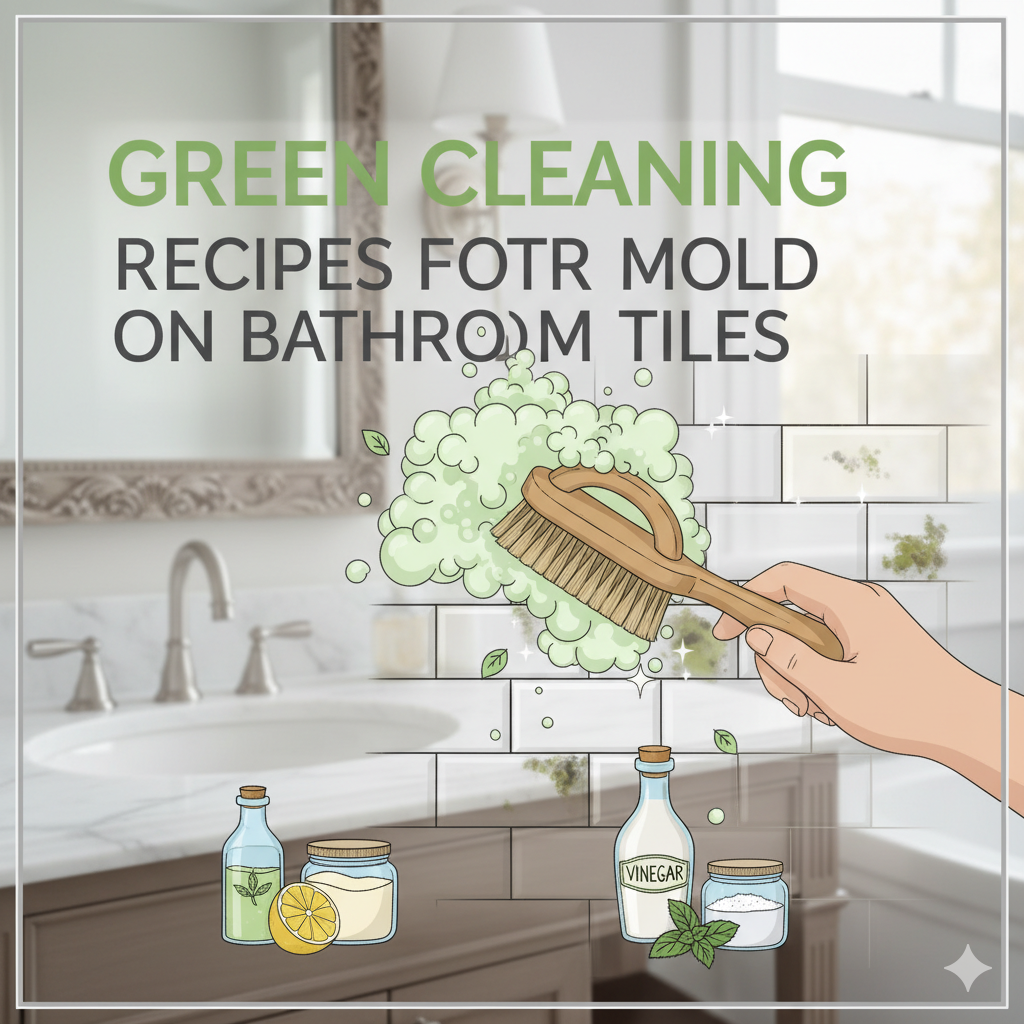Green cleaning guide: safe, effective recipes to remove mold from tiles
Mold on bathroom tiles is a common, stubborn problem — but you don’t need harsh chemicals to get rid of it. These green cleaning recipes for mold on bathroom tiles use inexpensive, non-toxic ingredients you probably already have at home. They’re safer for your family, pets, and plumbing while still powerful enough to lift mold and prevent regrowth.
This article breaks down simple, step-by-step green cleaning recipes for mold on bathroom tiles, plus the supplies, safety tips, and prevention habits that keep grout and caulk looking fresh. You’ll learn which natural ingredients work best (and when not to mix them), how long to let solutions sit, and which method suits heavy vs. light mold.
If you want an easy-to-follow plan that’s good for the planet and tough on mold, these green cleaning recipes for mold on bathroom tiles will give you multiple options — from vinegar and baking soda to hydrogen-peroxide-based mixes — so you can pick the one that fits your bathroom and schedule.
Why choose green cleaning for bathroom mold?
-
Protects indoor air quality — no lingering chemical fumes.
-
Safer for kids, pets, and septic systems.
-
Most ingredients are cheap, biodegradable, and multi-purpose.
-
Many natural treatments also help prevent mold return when used regularly.
Tools & safety (before you start)
-
Stiff nylon brush or old toothbrush for grout.
-
Spray bottle(s), rubber gloves, safety goggles (optional but recommended).
-
Microfiber cloths or disposable paper towels.
-
Ventilate the room — open a window or run the exhaust fan.
-
Test any recipe on a small area first to ensure it won’t discolor tiles or grout.
Green cleaning recipes (step-by-step)
1) White vinegar spray — best for light mold
Ingredients:
-
1 cup distilled white vinegar
-
1 cup warm water
Method:
-
Mix vinegar and warm water in a spray bottle.
-
Spray affected tiles and grout generously.
-
Let sit 30–60 minutes.
-
Scrub with a brush and rinse with warm water.
Notes: Vinegar is mildly acidic and kills many mold species; do not use on natural stone (marble, travertine) — it can etch stone.
2) Baking soda paste — great for scrubbing grout
Ingredients:
-
3 tbsp baking soda
-
1 tbsp water (adjust to make a paste)
Method:
-
Apply paste to grout lines and moldy spots.
-
Let sit 15–20 minutes.
-
Scrub with toothbrush or grout brush, then rinse.
Tip: For extra oomph, spray the area first with diluted vinegar, then apply the baking soda paste — you’ll get fizzy lift, but rinse well.
3) Hydrogen peroxide spray — for stubborn mold (safe on most surfaces)
Ingredients:
-
3% hydrogen peroxide (store-bought)
Method:
-
Pour hydrogen peroxide into a dark spray bottle (it degrades in light).
-
Spray moldy areas and leave 10–15 minutes.
-
Scrub and rinse.
Notes: Hydrogen peroxide is a safe oxidizer that kills mold spores and whitens grout without bleach.
4) Tea tree oil solution — natural antifungal (prevention + treatment)
Ingredients:
-
1 tsp tea tree oil
-
1 cup water
Method:
-
Mix and spray on tiles and grout.
-
Leave — no need to rinse for ongoing prevention, but wipe after a few hours if you dislike the scent.
Tip: Tea tree oil is potent; a little goes a long way and it has antifungal properties.
5) Oxygen bleach soak — for heavy staining (color-safe)
Ingredients:
-
Oxygen bleach powder (sodium percarbonate)
-
Warm water
Method:
-
Dissolve the recommended amount in warm water per product instructions.
-
Apply to stained grout/tiles or soak a cloth and lay it on the area.
-
Let sit 20–60 minutes, then scrub and rinse.
Notes: Oxygen bleach is safer than chlorine bleach for grout and won’t create toxic fumes when mixed with the other green ingredients — still follow product safety directions.
Quick routine to prevent mold returning
-
Keep bathroom ventilated: run fan during and after showers for 15–30 minutes.
-
Squeegee tiles after showering to remove excess moisture.
-
Use a diluted vinegar or tea-tree spray once weekly on grout lines.
-
Replace or repair leaking fixtures and re-caulk around tubs or showers when needed.
How to choose the right recipe
-
Light surface mold on glazed tile: try vinegar spray first.
-
Grimy grout stains: baking soda paste + scrubbing.
-
Dark, stubborn mold or recurring growth: hydrogen peroxide or oxygen bleach.
-
Ongoing prevention with a pleasant scent: tea tree oil solution.
FAQs
Q: Are these green cleaning recipes for mold on bathroom tiles safe around kids and pets?
A: Generally yes — they’re far safer than chlorine bleach. Still, store all solutions out of reach and keep children and pets out of the bathroom while you clean and until surfaces are dry.
Q: Can I mix vinegar and hydrogen peroxide?
A: Don’t mix them in the same bottle — while both are effective, mixing them creates peracetic acid which can be irritating. Use them sequentially (apply one, rinse, then apply the other) if you need both strengths.
Q: Will vinegar or baking soda damage grout or tile?
A: Vinegar can etch natural stone, so avoid it on marble, travertine, or limestone. Baking soda is mild and safe for most tiles and grout.
Q: How often should I deep-clean grout to prevent mold?
A: Every 1–3 months for most bathrooms; high-humidity, frequently used showers may benefit from monthly attention.
Troubleshooting & when to call a pro
-
If mold covers a very large area (roughly more than 10 sq ft) or returns quickly after cleaning, it may indicate moisture trapped in walls or under tiles — contact a mold remediation professional.
-
Persistent, black mold on porous materials (old caulk, drywall) often requires replacement.
Conclusion
These green cleaning recipes for mold on bathroom tiles give you safe, effective options that work without harsh industrial chemicals. Use vinegar or baking soda for everyday spots, hydrogen peroxide or oxygen bleach for tougher stains, and tea tree oil for prevention — together these green cleaning recipes for mold on bathroom tiles form a complete, eco-friendly approach you can rely on. Keep up simple habits like ventilating and squeegeeing, and these green cleaning recipes for mold on bathroom tiles will help keep your bathroom bright, healthy, and mold-free.

